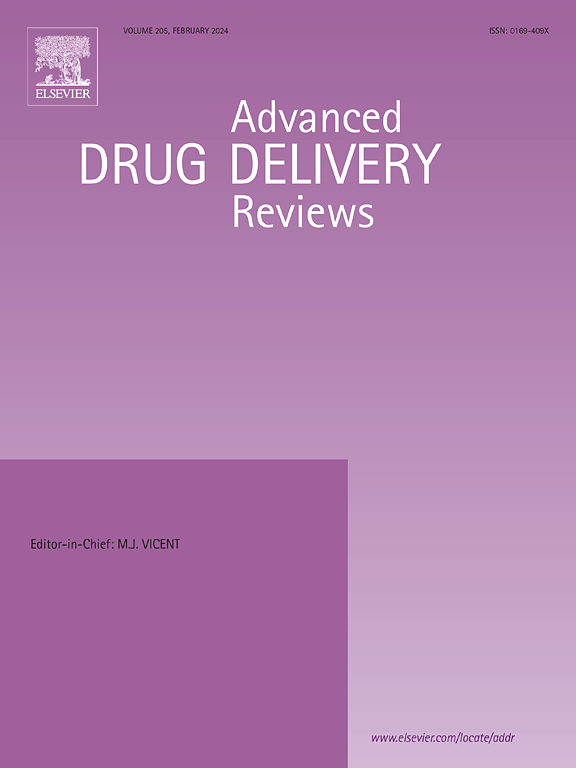Harnessing epigenetic inhibitors: A promising approach for overcoming challenges in pancreatic ductal adenocarcinoma treatment
IF 17.6
1区 医学
Q1 PHARMACOLOGY & PHARMACY
引用次数: 0
Abstract
Pancreatic ductal adenocarcinoma (PDAC) is an aggressive and often fatal form of malignancy frequently diagnosed at an advanced stage, posing significant challenges for treatment. The complex and intricate microenvironment of PDAC, characterized by heterogenous tumoral cells harbouring diverse mutations and epigenetic alterations, immune cells (primarily in an immunosuppressive state), cancer-associated fibroblasts (CAFs), low vascularization and extracellular matrix components supporting tumor growth, creates a physical barrier that impedes drug delivery and anti-tumoral immune cell responses, leading to therapy resistance. Despite advancements in early detection methods, and available treatments for PDAC—including surgery, radiotherapy, chemotherapy, and immunotherapy, all have shown limited efficacy. Recently, liposomal drugs in combination therapy, PDAC-targeted CAR-T cells and anti-tumor RNA vaccines have emerged as promising therapeutic approaches. However, significant challenges remain, including the presence of a dense stroma, resistance to chemotherapy, and robust immune suppression, all of which pose substantial barriers to effective treatments.
In this context, epigenetic therapy aims to modify gene expression patterns in PDAC cells, potentially curtailing their resistance. This review provides an overview of the current landscape of PDAC research and the role of epigenetic inhibitors in the treatment of this lethal disease, emphasizing the potential of combining these novel drugs with conventional chemotherapy or immunotherapy, new drug delivery approaches and future directions in the field. A multi-approach therapy, switch to simultaneously targeting various facets of the PDAC characteristics, could enhance the anti-tumoral efficacy by overcoming its resistance mechanisms, improving patient prognosis.


利用表观遗传抑制剂:克服胰腺导管腺癌治疗挑战的有希望的方法。
胰腺导管腺癌(PDAC)是一种侵袭性且通常致命的恶性肿瘤,通常在晚期诊断出来,对治疗提出了重大挑战。PDAC复杂而复杂的微环境,其特点是异质肿瘤细胞具有多种突变和表观遗传改变,免疫细胞(主要处于免疫抑制状态),癌症相关成纤维细胞(CAFs),低血管化和支持肿瘤生长的细胞外基质成分,形成阻碍药物传递和抗肿瘤免疫细胞反应的物理屏障,导致治疗耐药。尽管早期检测方法和现有的pdac治疗方法(包括手术、放疗、化疗和免疫治疗)取得了进步,但所有治疗方法的疗效都有限。最近,脂质体药物联合治疗、pdac靶向CAR-T细胞和抗肿瘤RNA疫苗已成为有希望的治疗方法。然而,重大挑战仍然存在,包括致密基质的存在,对化疗的耐药性和强大的免疫抑制,所有这些都对有效治疗构成了实质性障碍。在这种情况下,表观遗传疗法旨在改变PDAC细胞中的基因表达模式,潜在地减少它们的耐药性。本文综述了PDAC研究的现状和表观遗传抑制剂在这种致命疾病治疗中的作用,强调了这些新药与传统化疗或免疫治疗联合的潜力,新的药物递送方法和该领域的未来方向。多途径治疗,切换到同时针对PDAC的各个方面的特点,可以通过克服其耐药机制,提高抗肿瘤疗效,改善患者预后。
本文章由计算机程序翻译,如有差异,请以英文原文为准。
求助全文
约1分钟内获得全文
求助全文
来源期刊
CiteScore
28.10
自引率
5.00%
发文量
294
审稿时长
15.1 weeks
期刊介绍:
The aim of the Journal is to provide a forum for the critical analysis of advanced drug and gene delivery systems and their applications in human and veterinary medicine. The Journal has a broad scope, covering the key issues for effective drug and gene delivery, from administration to site-specific delivery.
In general, the Journal publishes review articles in a Theme Issue format. Each Theme Issue provides a comprehensive and critical examination of current and emerging research on the design and development of advanced drug and gene delivery systems and their application to experimental and clinical therapeutics. The goal is to illustrate the pivotal role of a multidisciplinary approach to modern drug delivery, encompassing the application of sound biological and physicochemical principles to the engineering of drug delivery systems to meet the therapeutic need at hand. Importantly the Editorial Team of ADDR asks that the authors effectively window the extensive volume of literature, pick the important contributions and explain their importance, produce a forward looking identification of the challenges facing the field and produce a Conclusions section with expert recommendations to address the issues.

 求助内容:
求助内容: 应助结果提醒方式:
应助结果提醒方式:


